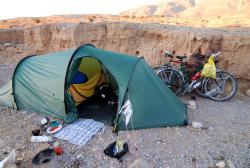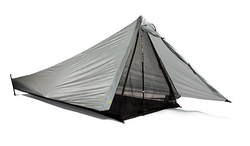 A tent is perhaps the most crucial piece of equipment that the independent bicycle tourist will carry.
A tent is perhaps the most crucial piece of equipment that the independent bicycle tourist will carry.
It will be your home away from home, a haven from wind, rain and cold temperatures, a key to travelling on a budget and one of the few constants that appears every night as you go from place to place. Choose well and your tent will be your best friend. Pick poorly and it may be the cause of more than a few unprintable words!
There are an overwhelming number of tents to choose from. How to pick? Start by looking for a few crucial features:
- As lightweight as possible – Tents made for car camping are like big lumps of lead! Try to find a tent that weighs between 2-4kg; towards the lighter end if you’re going solo and a bit more if you’re travelling with a partner.
- Muted colours – A bright orange tent looks pretty in the shop but it’s hardly ideal when you’re trying to wild camp in the woods. Get something that will blend in with your surroundings. Even if you don’t intend to free camp, you never know when an unexpected rain storm or some other event will change those plans and being as invisible as possible will help ensure you don’t attract attention.
- Packed Size – Make sure it packs down small enough to fit in your panniers, trailer or across the back luggage rack of your bike.
- Easy Set-up – If you intend to do any amount of camping, you can be sure there will be at least one day where you’re trying to set your tent up in the dark, in the middle of a gale-force wind or with hordes of mosquitoes attacking every inch of bare flesh. This is not the time to be fiddling with 20 poles and an incomprehensible series of hoops, loops and straps. Get the simplest set-up system possible.
 Everything else when it comes to tents is really a matter of personal preference and your plans. For camping across the seasons, look seriously at a double-walled tent that will insulate against the cold. For warmer climates, something single-walled and well ventilated will keep you safe from bugs, while still allowing a nice breeze to flow through. Shorter trips probably mean you don’t need as much space, while on extended journeys you’re likely to value the extra room that buying a slightly larger tent brings.
Everything else when it comes to tents is really a matter of personal preference and your plans. For camping across the seasons, look seriously at a double-walled tent that will insulate against the cold. For warmer climates, something single-walled and well ventilated will keep you safe from bugs, while still allowing a nice breeze to flow through. Shorter trips probably mean you don’t need as much space, while on extended journeys you’re likely to value the extra room that buying a slightly larger tent brings.
A freestanding tent will let you set the tent up first and stake it out later. It also makes things easier on hard ground but we have found you can set up any tent without pegs by attaching the straps and strings that come with most tents to the rocks, trees and even picnic tables – whatever is in the area.
If you do go with a freestanding tent, don’t be tempted to leave the pegs at home. It might save weight but you never know when a storm will blow through and you need to fully secure your tent. Pegs also tend to bend or break at the most unfortunate times and it’s always best to have a few in reserve.
Here are a few tents that are tried, tested and loved by bike tourers:
Hilleberg Nallo 3GT Our tent of choice comes from Swedish tent maker Hilleberg. We’ll warn you now, the 2.8kg Nallo 3GT is light in weight but heavy on your wallet. Expect to fork out about $865 for this tent (the one we took on our world tour) but price brings quality and this tent, with its roomy vestibule and separated sleeping area, has never failed us. In 15+ hours of a downpour in New Zealand, we were perfectly dry. In strong winds, our tent gracefully flexed with the gusts, without ever breaking a pole. And, most importantly, we felt the durability of the Nallo 3GT (we slept over 400 nights in our first one and it was still functioning perfectly, if a little thin from UV damage when we replaced it) and the customer service from Hilleberg was top-notch. If you can afford it, you won’t regret this tent for serious expeditions. For solo tourers, Hilleberg also make the 1.5kg Akto.
Our tent of choice comes from Swedish tent maker Hilleberg. We’ll warn you now, the 2.8kg Nallo 3GT is light in weight but heavy on your wallet. Expect to fork out about $865 for this tent (the one we took on our world tour) but price brings quality and this tent, with its roomy vestibule and separated sleeping area, has never failed us. In 15+ hours of a downpour in New Zealand, we were perfectly dry. In strong winds, our tent gracefully flexed with the gusts, without ever breaking a pole. And, most importantly, we felt the durability of the Nallo 3GT (we slept over 400 nights in our first one and it was still functioning perfectly, if a little thin from UV damage when we replaced it) and the customer service from Hilleberg was top-notch. If you can afford it, you won’t regret this tent for serious expeditions. For solo tourers, Hilleberg also make the 1.5kg Akto.
 For warm-weather trips, this freestanding tent could be an excellent choice for a solo tourer or two very good friends. The MSR Hubba Hubba ($239.93 from REI) has a frame that is based around the inner layer, which means you can leave the fly-sheet off in dry weather for great ventilation and evening star gazing.
For warm-weather trips, this freestanding tent could be an excellent choice for a solo tourer or two very good friends. The MSR Hubba Hubba ($239.93 from REI) has a frame that is based around the inner layer, which means you can leave the fly-sheet off in dry weather for great ventilation and evening star gazing.
At a mere 2kg, it’s hardly going to weigh you down and in 2011 MSR brought out a green model (much better for wild camping than the earlier models, which were bright yellow). The Hubba Hubba is also excellent value: less than half the cost of a Hilleberg. Peter Gostelow is using this tent for his Big Africa Cycle.
 The Big Agnes Copper Spur tent ($499.95 from REI for the 3-person version) has been used and loved by many bike tourists, including Tara & Tyler and Laura & Russ.
The Big Agnes Copper Spur tent ($499.95 from REI for the 3-person version) has been used and loved by many bike tourists, including Tara & Tyler and Laura & Russ.
It’s roomy and relatively light (2.2kg for the 3-person version). There are also doors on each side, which makes it easy to get in and out, especially if you’re sharing space with someone else.
Tarptent Contrail
 This tent took top place for solo travellers in Backpacker Magazine’s 2009 buyer’s guide and it’s very hard to find a bad word about it on the web. It weighs in at just 700g, costs a modest $199 and gets almost universal rave reviews. What’s the catch? Some people say it’s prone to condensation and can let in quite a breeze – not a good thing at higher altitudes or in chilly weather. It may also feel a bit cramped if you have to stay in it for a long time in bad weather, but then for the money you’ve saved compared to other tents, you can probably afford a hotel.
This tent took top place for solo travellers in Backpacker Magazine’s 2009 buyer’s guide and it’s very hard to find a bad word about it on the web. It weighs in at just 700g, costs a modest $199 and gets almost universal rave reviews. What’s the catch? Some people say it’s prone to condensation and can let in quite a breeze – not a good thing at higher altitudes or in chilly weather. It may also feel a bit cramped if you have to stay in it for a long time in bad weather, but then for the money you’ve saved compared to other tents, you can probably afford a hotel.
 We recently had a chance to admire the Macpac Citadel tent that our friends Trevor & Simone are using. They’ve put the tent through its paces during a 2-month trip from Jordan to the Netherlands, and they really like it.
We recently had a chance to admire the Macpac Citadel tent that our friends Trevor & Simone are using. They’ve put the tent through its paces during a 2-month trip from Jordan to the Netherlands, and they really like it.
We think it’s neat too. There are 2 entrances to the sleeping area, and 2 porches – a large one for cooking and a smaller one for reading or relaxing. With lots of space, it seems like the perfect tent for couples – and perhaps a rival to our Hilleberg Nallo 3GT.
The photo shows you what the Macpac Citadel looks like when all the doors are closed. You can’t tell in this photo, but there are 2 happy cyclists inside, waiting for the rain to stop!
The cost of the Macpac Citadel is about €600 in Europe, compared to roughly €800 for the Hillberg. It also compares favourably if you’re tall. Andrew (180cm or 5’11”) sometimes finds his feet brushing against the end of the Nallo 3GT, while Trevor is 190cm or 6’3″ but can still stretch out in the Macpac Citadel.
On the downside, the Macpac Citadel weighs 3.4kg – a bit more than the Nallo 3GT (2.9kg). That said, if you value the ability to have your own space (and tent entrance), more than counting every gram, it could be just the ticket.
Here are even more suggestions for a good night’s sleep, from our Twitter followers:
Christine & I love our Big Agnes Seedhouse SL2. @kentsbike
Big Agnes Seedhouse 2. Easy to pitch, light, and plenty of room for 1. Also a subdued green colour for wild camping. @cycle4india
Our group of five or six uses the @ENOHammocks – with a little rope we have no problem finding trees in the southeast U.S. @Jonahchitty
Macpac Citadel or Macpac Minaret
Macpac Citadel – plenty of space and not heavy. The Minaret is a smaller, lighter 4-season alternative. @Oddcats
MSR Mutha Hubba is a great size for two sharing. But if weather permits I love to sleep outside in a bivvy bag! @tomsbiketrip
Rab Ridge Raider or Hilleberg Akto
Rab Ridge Raider. Light & quick to pitch, but small. If I was camping every night I’d take my Hilleberg Akto.” @Bazzargh
Terra Nova Duolite Tourer is our choice as a cycle touring tent. @Davebikenotes
Vango Tempest 300. Cheap, ok weight, ok packsize, spacious, porch big enough for a bike with wheels off. @Aegisdesign
Vaude Hogan Ultralight. It was my second home during my bike ride. I had to change one zipper, the rest is still great. @Mk4220
Have some thoughts on tents, or maybe a question? Leave a comment!
